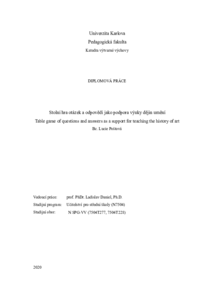Stolní hra otázek a odpovědí jako podpora výuky dějin umění
Table game of questions and answers as a support for teaching the history of art
diplomová práce (OBHÁJENO)

Zobrazit/
Trvalý odkaz
http://hdl.handle.net/20.500.11956/125140Identifikátory
SIS: 213642
Kolekce
- Kvalifikační práce [20518]
Autor
Vedoucí práce
Oponent práce
Raudenský, Martin
Fakulta / součást
Pedagogická fakulta
Obor
Učitelství všeobecně vzdělávacích předmětů pro základní školy a střední školy speciální pedagogika - výtvarná výchova
Katedra / ústav / klinika
Katedra výtvarné výchovy
Datum obhajoby
13. 1. 2021
Nakladatel
Univerzita Karlova, Pedagogická fakultaJazyk
Čeština
Známka
Výborně
Klíčová slova (česky)
stolní hra, dějiny umění, vzdělávání, kvíz, otázky, odpovědiKlíčová slova (anglicky)
table game, history of art, education, quiz, questions, answersDiplomová práce se jako celek zabývá tématem deskovými hrami. Je rozdělena na tři části, část teoretickou, praktickou a didaktickou. V teoretické části se autorka věnuje ikonografii deskových her a hraní od středověku po současnost. Užívání deskových her je interpretováno na konkrétních uměleckých dílech v malířství, sochařství a uměleckém řemesle. Praktická část byla zaměřena na tvorbu stolní vzdělávací hry dějiny umění, která formou kvízu s otázkami a odpověďmi z dějin umění rozvíjí znalosti uměleckohistorické oblasti. Hra byla přetvořena jako digitální/online verze a mobilní aplikace. Verze hry byly vytvořeny v jednotném autorském designu. V didaktické části autorka na základě vytvořené vzdělávací hry zkoumá, zda je hra vhodným výukovým materiálem pro pedagogy, studenty i skupinu respondentů z širší veřejnosti. Součástí je také metodika pro pedagogy středních škol, jak s hrou ve výuce zacházet.
The diploma thesis deals with the topic of board games. It is divided into three parts, the theoretical, practical and didactic part. In the theoretical part, the author describes iconography of board games and playing board games from the Middle Ages to the present time. The use of board games is interpreted on specific works of art in painting, sculpture and crafts. The practical part was focused on the creation of an art history educational board game, which develops knowledge in the form of a quiz with questions and answers. The game was redesigned as a digital / online version and a mobile application. Versions of the game were created in a unified author's design. In the didactic part, the author examines whether the game is a suitable teaching material for teachers, students and a group of respondents from the general public. It also includes a methodology for secondary school teachers on how to deal with play in teaching.
